A cold morning 2 days before Christmas found Blane Chapman and two apprentices shoeing at the famed 6666 Ranch in Guthrie, Texas. They didn’t let the closeness of the holiday keep them away, because it was Monday, and Blane has been traveling the 100 miles from Lubbock to Guthrie every Monday for 14 years.
The Four Sixes, along with the Dixon Creek Ranch, covers 275,000 acres in the Rolling Plains and Panhandle of Texas. In addition to a substantial cattle program, the ranch is also known for its Quarter Horses. The Sixes has a sizeable mare herd and stands 30 stallions.
Chapman and his team take care of those mares and stallions, plus he trims colts and recipient mares, shoes the sale colts, shoes the cowboy horses, show horses and even some racehorses. It’s a lot of work for the 45-year-old Chapman. “It’s not for the weak-hearted,” he adds.
With all the horses to work on, Chapman needs help. He usually takes his brother Baker, as well as two apprentices.
“If it wasn’t for Baker, I’d be out of business,” Chapman says. On that December day, Baker wasn’t present since he had left town for Christmas, but the two apprentices, Austin Garvin and Tommy Walters, were both in attendance.
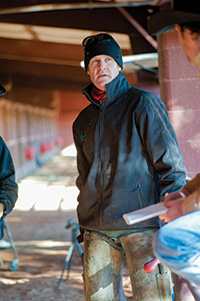
With all the horses to be done at the Sixes, everyone stays busy. They always have several horses being worked with at the same time. Left: Blane Chapman has been shoeing for the 6666 Ranch for 14 years, working on everything from geldings to race sires.
The work is divided according to what needs being done. Sometimes the four stay together, while at other times Chapman might send the apprentices to trim broodmares while he and Baker shoe the studs. One of the Chapmans always shoes the studs and certain other horses, but the apprentices have a lead role on many of the horses.
Everyone’s jobs vary, too. Chapman might pull shoes on a mare that an apprentice is shoeing, if that is the efficient thing to do at the moment.
“If somebody needs a hand, we try to step in and help, no matter our position,” he says. Everyone knows the drill, he adds, and no one stands around. “The point is for anyone to step in and help.”
Chapman likes to keep things rolling so much that for his regular Thursday stop at a race training track, he hires three extra helpers whose job is only to catch and hold horses. At the Sixes, there are always plenty of horse holders, typically interns from the breeding program. A veterinarian is always nearby to sedate a horse when necessary.
Demands On The Ranch
Each week, the ranch gives Chapman a list of what needs to be shod. The stallions are shod every 6 weeks and the mares are trimmed every 8 weeks. The Sixes owns about 125 broodmares, and they breed about 1,200 outside mares per year.
With that many horses at the ranch, the list is long each week. Chapman and his crew have trimmed as many as 80 mares in a day, and they have trimmed up to 60 weanlings by lunchtime. “But that’s with people helping us, holding them,” Chapman explains.
When asked how nice of a trim the broodmares get, Chapman answers, “To be honest, it depends on how good the mare stands.” With their 8-week trimming schedule, the mares really aren’t that tough to maintain.

Chapman uses his forge a lot, but only when it’s necessary, as was the case for these sliding plates.
The first trim is very thorough, and Chapman says they get them on the foot stand and give them a nice finish, and certainly remove all the flares. “We try to make it where it’s easier on us the next time.”
After that initial trim, the succeeding trims are nice, solid trims, but the finish might only be a beveling of the edge.
“They’ll maintain their feet pretty well if we help them,” he says.
The stallions at the Sixes get a variety of hoof care, depending on what the individual requires. Some are shod all the way around, some are shod only on the fronts and others are kept barefoot. Several of them have old injuries or problems that require some corrective work. “We treat them all different,” Chapman says. “It just depends on what they need.”
Many of the race colts raised on the ranch are sold as yearlings at one of the fall sales, such as the All-American Sale. Those colts are all trimmed regularly for 6 months beforehand and then shod on the fronts just before the sale.
Those colts are shod on the fronts to protect the feet and as insurance for soundness. Some of the colts sell for hundreds of thousands of dollars, and nobody wants to see one step on a rock and take a lame step. Chapman shoes them with St. Croix Concords, which he likes for the colts because of their shape. “They almost take the work out of it,” he says of those shoes.
All In A Day’s Work
That morning a mare was led up to be shod on the front and left barefoot on the hinds. A few mares are shod on the fronts when lameness makes it necessary. Every horse can go bare, he says, but they can’t all stay sound that way.
This mare was pigeon-toed, but the reason Chapman shoes her is that she’s thin-soled and prone to abscesses. To combat this, Chapman used Magic Cushion covered by a leather pad. For years he used plastic pads, but has now gone back to leather.
He did not try to change the crooked legs on the mare, saying he never tries to straighten anything on a horse that old. In those cases, he shoes them level and might try to enhance the breakover.

Although he has a unique handmade horsehead clinch block, as often as not, Chapman blocks his nails with his rasp. Whatever is handy.
“At this point, we’re not going to fix that,” Chapman says. “A lot of these horses have lameness issues we’re not going to fix.”
The Four Sixes takes better care of its horses than most breeding farms, Chapman finds. He works with the two on-site veterinarians a lot, but in many cases there is only so much that can be done. In those cases, he just tries to keep the horses comfortable and productive.
He will try to straighten crooked-legged colts, and that is part of his job at the 6666 Ranch. “From birth until 6 months is the time to do something with the foal,” he says. Most, Chapman explains, will straighten out with nothing more than correct trimming and time. In extreme cases when a horse has not straightened sufficiently after 6 months of age, Chapman believes a veterinary procedure is necessary.
Chapman and his apprentices spent the morning shoeing sale horses that Sixes employee Tru Burson was getting ready for a couple of upcoming sales. Chapman claimed it was a slow day, being that close to Christmas, but all three men worked continually and the horses rolled through.
Those sale horses were shod all the way around, with sliding plates on the hinds. His apprentices shod the fronts on a couple of them, but Chapman shod the hinds on all of them.
He nailed on a pair of sliding plates that came with rocker toes. When asked whether he preferred sliders with rocker toes, Chapman was ambivalent. Those particular shoes came with the rocker toes, so he nailed them on. He usually doesn’t use rocker toes on sliding plates.
He doesn’t take much credit for his shoeing giving a horse a nice sliding stop. It’s all about the horse’s ability and the ground it is working on. If sliding was all about shoeing, he explains, any horse could slide 50 feet with a pair of sliding plates.
While Chapman is an excellent blacksmith, he shoes most horses cold because he finds it more efficient in his practice. He still uses his forge a lot for special shoes that require a lot of hammering. At the Sixes that day he hot shaped and fit all the sliding plates, but the front shoes were all shaped cold.
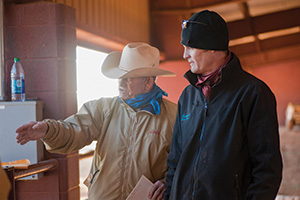
Legendary Four Sixes cowboy Boots O’Neil stopped by for a visit.
The need to burn a shoe on varies depending on where and in what conditions a horse lives. In dry West Texas, Chapman doesn’t like it.
“Out here, a hot shoe pulls moisture from the foot,” he says.
Those young sale horses Chapman was shoeing all got a very nice finish, even though the sales weren’t coming up for a few months.
Chapman is well-known in the area for his nice finishes. He rasps the entire hoof, although lightly in most areas, on every horse he works on, most colts and broodmares excluded. “To me, there’s more to shoeing a horse than the bottom of its foot,” Chapman says.
A nice finish lets everyone know that he takes pride in his work. “You never know who is going to see your work, and people will pick it apart,” he says. “I want them to have to work at it.”
That thinking on finishes came later in life — his father, legendary farrier Burney Chapman, never did it. That led the younger Chapman into talking about his dad, and how he learned footcare from the elder Chapman. Growing up, he says, he thought Burney was the only person who really knew how to shoe a horse. (See Page 70 sidebar.)
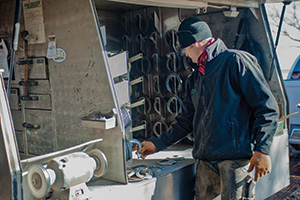
Even though Chapman can build shoes, he prefers ready-mades. He keeps a large inventory in his trailer and would carry more if he could.
“It wasn’t until later that I learned that there are a lot of guys that can shoe.”
Burney always told his sons all the new things he learned about shoeing. But, Chapman says, many of those things were learned because he had been off somewhere shoeing lame horses and talking to veterinarians and other horseshoers. Because of that, Chapman believes everyone should always be open to new ideas and willing to learn.
Familiar Schedule
These days Chapman has a set schedule that he follows every week. He spends Mondays at the Sixes, with the following day spent in his shop or with local clients. On Wednesdays, he works at the Brock Veterinary Clinic in Lamesa, Texas, about midway between Lubbock and Midland. Each Thursday, he shoes at trainer Blane Wood’s training track in Lubbock. He spends Fridays in his home shop and doesn’t work on weekends.
He likes this schedule, and it keeps Chapman from driving here and there to shoe a horse or two. He stresses that he doesn’t think he’s too good for it now — he just doesn’t want to do it. He used to drive quite a bit early in his career, but felt he needed to change that program.
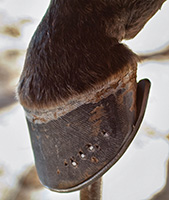
A nice finish is mandatory in Chapman’s shoeing. He believes it shows pride in his work, and it’s one less thing a critic could pick apart.
Over the years, Chapman has had many different shoeing rigs, both truck bodies and trailers. Currently, he pulls a Stonewell trailer that he bought used. The trailer may have been around a while, but it’s outfitted with just about every tool a horseshoer could need.
He carries a wide variety of shoes and wishes he could carry more. He’ll need them all at one point or another in his regular work. He likes to try new products, and he says a horseshoer’s job is to stay open-minded and not get sold on only relying on a certain product. Even so, he maintains that the most important thing is to keep things simple.
Sometimes he runs into things that would benefit the horse but really aren’t efficient or profitable for his practice. Chapman says he chooses to do them anyway, because he owes it to the horse. “I owe everything I have to the horse,” he concludes.

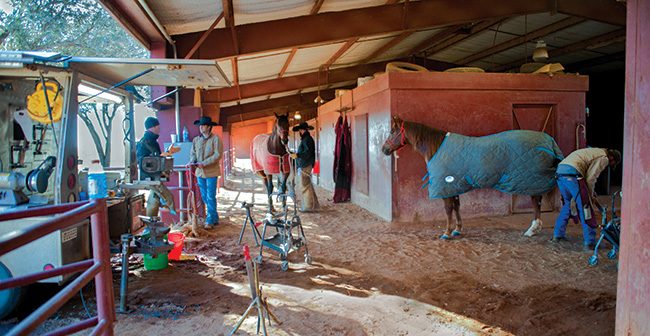






Post a comment
Report Abusive Comment